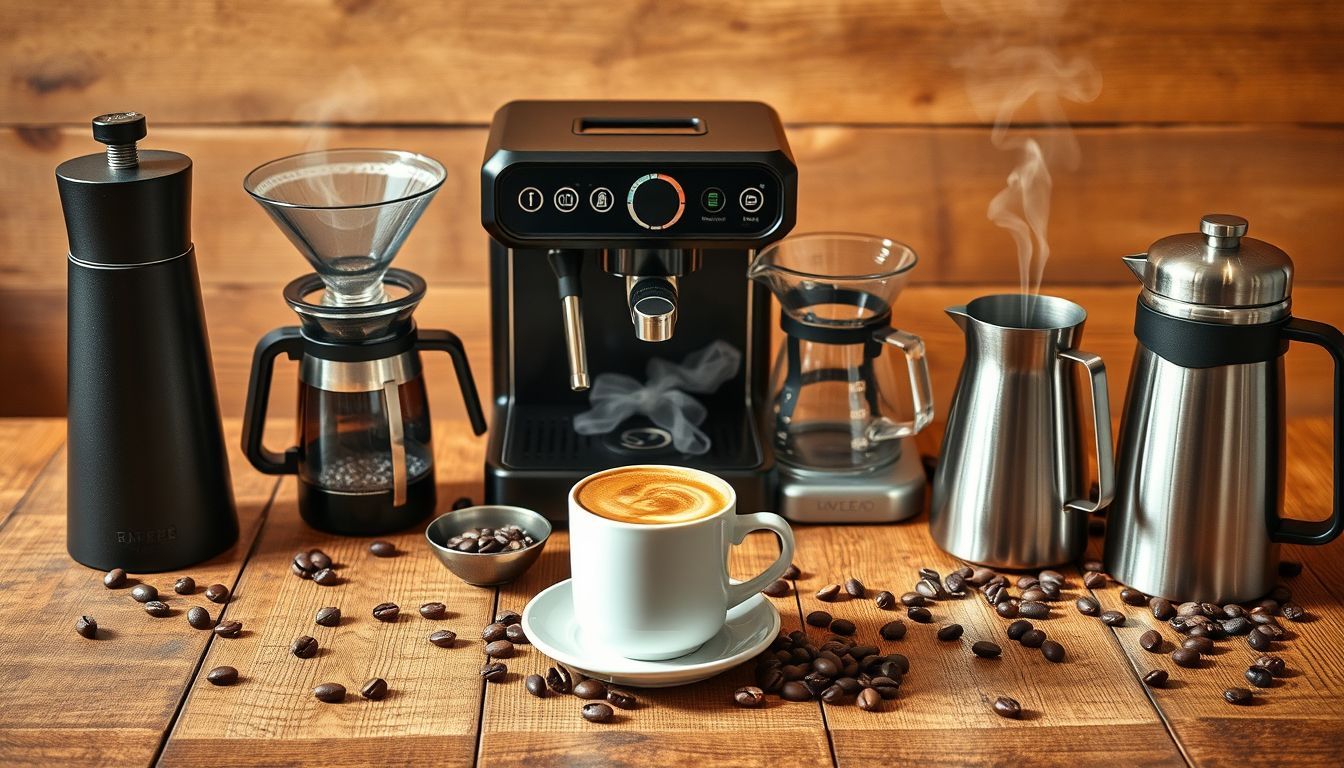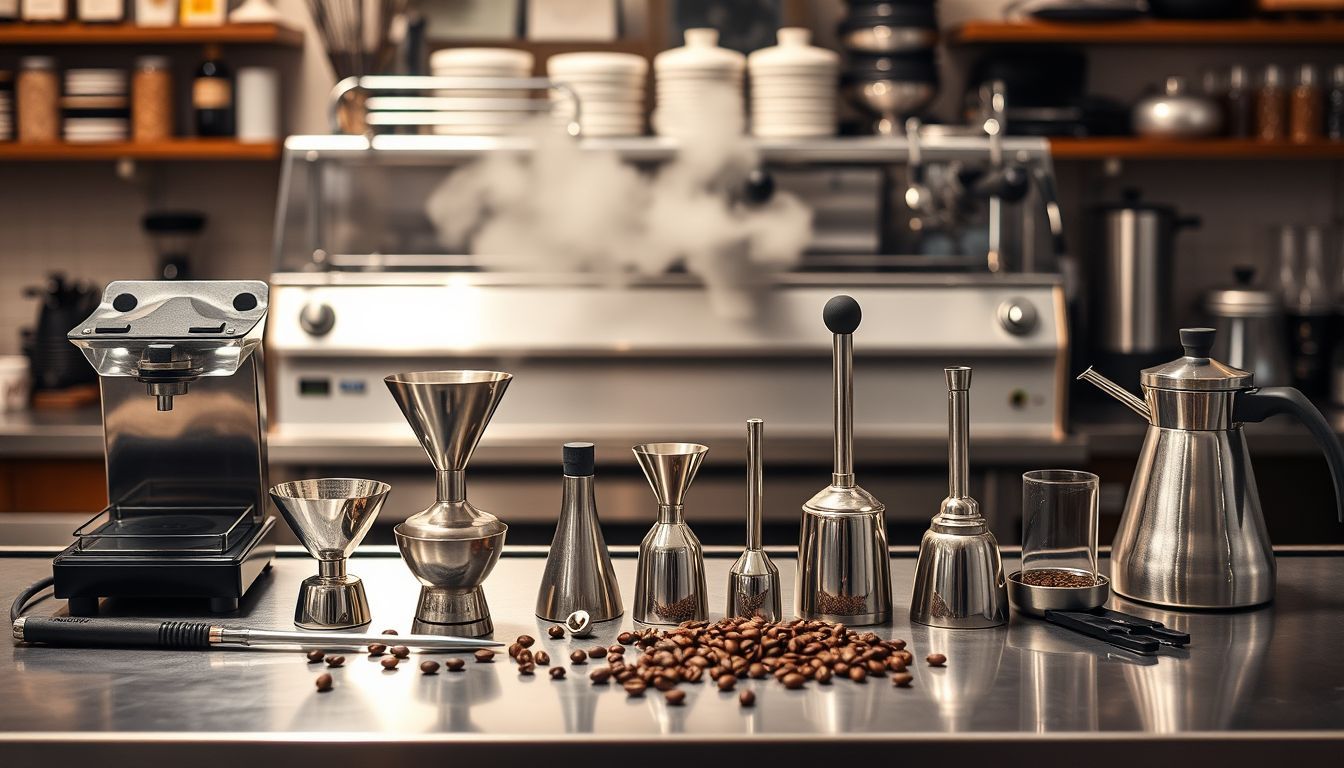Why This Coffee Accessory Reduces Waste by 90% (And Saves You Money)
Discover how reusable metal filters eliminate paper waste while improving coffee flavor. From environmental impact to cost savings, this simple switch transforms your brewing.

Amazon Affiliate Disclosure
This post contains affiliate links. If you purchase through these links, we may earn a small commission at no additional cost to you.
Why This Coffee Accessory Reduces Waste by 90% (And Saves You Money)
Last month, I calculated something that made me question my entire coffee routine: over the past year, I had used 1,460 paper filters for my daily pour-over ritual. That's four pounds of paper waste, $73 in filter costs, and countless trips to the store when I inevitably ran out at the worst possible moment. The math was sobering, but what really got my attention was realizing that this waste was completely unnecessary.
The solution sitting in my equipment drawer—a simple metal filter I'd dismissed as a “backup option”—had been quietly waiting to eliminate 90% of my coffee brewing waste while actually improving the flavor of my daily cup. If you’re still reaching for disposable filters, consider upgrading to a reusable option like the BINCOO Pour Over Coffee Dripper. It’s a durable stainless steel filter that fits most drippers and instantly cuts out paper waste.
As someone who analyzes coffee industry trends and environmental impacts, I’ve become fascinated by how small changes in our brewing habits can create massive cumulative effects. The humble reusable metal filter represents one of the most impactful yet underappreciated accessories in coffee brewing—capable of eliminating billions of paper filters from landfills while often producing better-tasting coffee.
Today, we’re exploring why metal filters are environmental game-changers, how they actually improve coffee flavor in many cases, and why this simple switch might be the most important coffee accessory upgrade you never considered.
The Hidden Environmental Cost of Paper Filters
Before diving into solutions, let’s understand the scope of the problem that paper filters create in our daily coffee routines.
The Numbers Behind Paper Filter Waste
Individual Impact
The average coffee enthusiast using pour-over methods consumes:
- 365–730 paper filters annually (1–2 per day)
- 2–4 pounds of paper waste per year
- $50–$150 in filter costs annually
- Packaging waste from filter boxes and plastic wrapping
Global Scale Impact
With millions of coffee drinkers worldwide:
- Billions of paper filters end up in landfills annually
- Thousands of tons of bleached paper production
- Significant water usage in paper manufacturing
- Transportation emissions from global filter distribution
The Manufacturing Reality
Paper Production Process
Coffee-filter paper requires:
- Virgin wood pulp (recycled paper lacks necessary strength)
- Chlorine bleaching for white appearance
- Chemical treatments for wet strength
- Energy-intensive manufacturing processes
Environmental Footprint
Each paper filter represents:
- 0.5–1 gallon of water used in production
- Chemical runoff from bleaching processes
- Carbon emissions from manufacturing and transport
- Non-recyclable waste due to coffee oil contamination
The Convenience Trap
Why We Choose Disposable
Paper filters seem appealing because they offer:
- No cleaning required
- Consistent availability
- Familiar brewing results
- Marketing that emphasizes “purity” and “clarity”
Hidden Costs
But this convenience comes with:
- Ongoing purchase requirements
- Storage space needs
- Supply-chain dependency
- Cumulative environmental impact
If you’re after convenience without waste and still want a full-bodied cup, consider a machine like the Cuisinart 12-Cup Coffee Maker with Thermal Coffee Carafe. It features a built-in reusable filter, so you never need paper again.
Metal Filters: The 90% Waste Reduction Solution
Reusable metal filters eliminate the vast majority of coffee brewing waste while offering unique advantages that many coffee drinkers have never experienced.
How Metal Filters Work
Construction and Design
Metal coffee filters typically feature:
- Stainless steel mesh construction
- Precision-engineered hole patterns
- Durable frames that fit standard brewing devices
- Easy-clean surfaces that resist coffee oil buildup
Filtration Mechanism
Unlike paper filters that trap everything:
- Metal filters allow coffee oils to pass through
- Fine particles are filtered while preserving body
- Natural coffee compounds remain in the final cup
- No chemical interaction with coffee compounds
The Waste Reduction Mathematics
Direct Waste Elimination
Switching to metal filters eliminates:
- 100% of paper filter waste
- 100% of filter packaging waste
- 90%+ of total brewing waste (coffee grounds remain)
- Ongoing filter purchase requirements
Lifecycle Comparison
A quality metal filter:
- Lasts 5–10 years with proper care
- Replaces 1,800–3,600 paper filters over its lifetime
- Pays for itself within 3–6 months
- Reduces waste by 90% compared to paper alternatives
Environmental Impact Analysis
Carbon Footprint Reduction
Metal filters reduce environmental impact through:
- Elimination of ongoing paper production
- Reduced transportation emissions
- No chemical bleaching processes
- Minimal packaging requirements
Resource Conservation
Long-term benefits include:
- Water savings from eliminated paper production
- Reduced chemical runoff
- Forest conservation through reduced paper demand
- Decreased landfill burden
Flavor Benefits: Why Metal Often Tastes Better
Contrary to popular belief, metal filters often produce more flavorful coffee than their paper counterparts by preserving compounds that paper filters remove.
The Science of Coffee Oil Preservation
What Paper Filters Remove
Paper filtration eliminates:
- Coffee oils that contribute to body and mouthfeel
- Fine particles that add texture
- Aromatic compounds bound to oils
- Natural coffee colloids that enhance flavor
What Metal Filters Preserve
Metal filtration maintains:
- Full spectrum of coffee oils
- Natural body and texture
- Complete aromatic profile
- Unfiltered flavor complexity
Taste Profile Differences
Paper Filter Characteristics
- Clean, bright acidity
- Light to medium body
- Clarity of individual flavor notes
- Minimal sediment
- Sometimes described as “thin” or “lacking body”
Metal Filter Characteristics
- Fuller body and mouthfeel
- Rich, complex flavor profiles
- Enhanced aromatics
- Natural coffee texture
- More “complete” coffee experience
Brewing Method Optimization
Pour-Over with Metal Filters
Optimal technique adjustments:
- Slightly coarser grind to prevent over-extraction
- Slower pouring to control flow rate
- Attention to water temperature (195–205°F)
- Consistent circular pouring patterns
For V60 enthusiasts, pairing your device with the Hario V60 Ceramic Coffee Dripper, Size 02, White and a matching stainless steel mesh filter elevates both flavor and sustainability.
French Press Enhancement
Metal filters can improve French press by:
- Reducing sediment while preserving oils
- Creating cleaner final cup
- Maintaining full body characteristics
- Easier cleanup than traditional mesh
A great starter French press with mesh system is the Sivaphe French Press Coffee Maker, 304 Stainless Steel Coffee Press, with 4 Filters System, which combines durability and improved clarity.
For a classic borosilicate option, consider the YMMIND French Press Coffee Maker (34oz 1Quart 5-6Cup), perfect for enhancing body and aroma.
Economic Analysis: The Money-Saving Reality
Initial Investment vs. Ongoing Costs
Paper Filter Annual Costs
- V60 filters: $40–$60 per year
- Chemex filters: $60–$100 per year
- Generic filters: $20–$40 per year
- Specialty filters: $80–$150 per year
Metal Filter Investment
- Quality metal filter: $25–$50 one-time cost
- Lifespan: 5–10 years
- Annual cost: $2.50–$10 per year
- Payback period: 3–12 months
Five-Year Cost Comparison
Paper Filter Path:
- Annual filter costs: $60 average
- Five-year total: $300
- Environmental impact: High
- Convenience: Medium (requires restocking)
Metal Filter Path:
- Initial investment: $35 average
- Five-year total: $35
- Environmental impact: Minimal
- Convenience: High (no restocking needed)
Net Savings: $265 over five years
Hidden Cost Considerations
Paper Filter Hidden Costs
- Storage space requirements
- Emergency store runs when out of filters
- Shipping costs for online orders
- Time spent managing filter inventory
Metal Filter Hidden Benefits
- Never running out of filters
- Reduced storage needs
- No ongoing purchase decisions
- Simplified coffee setup
Maintenance and Care for Longevity
Daily Cleaning Routine
After Each Use:
- Rinse immediately with hot water
- Gently brush away coffee particles
- Inspect for clogs or damage
- Air dry completely before storage
Why Immediate Cleaning Matters:
- Prevents coffee oil buildup
- Maintains optimal flow rate
- Extends filter lifespan
- Ensures consistent flavor
Weekly Deep Cleaning
Deep Clean Process:
- Soak in warm, soapy water for 15 minutes
- Use soft brush to remove stubborn particles
- Rinse thoroughly with hot water
- Inspect mesh for wear or damage
- Air dry completely
For Stubborn Buildup:
- Baking soda paste for gentle abrasion
- White vinegar soak for mineral deposits
- Soft toothbrush for detailed cleaning
- Never use harsh chemicals or abrasives
Long-Term Maintenance
Monthly Inspection:
- Check for holes or tears in mesh
- Verify frame integrity
- Test flow rate consistency
- Replace if performance degrades
Signs of Replacement Need:
- Visible holes or tears
- Significantly slower flow rate
- Persistent off-flavors
- Frame damage or warping
Addressing Common Concerns
“Metal Filters Produce Muddy Coffee”
The Reality:
Properly used metal filters produce full-bodied coffee, not muddy coffee. Issues arise from:
- Grind size too fine for metal filtration
- Poor pouring technique
- Low-quality filter construction
- Inadequate cleaning
Solutions:
- Use slightly coarser grind than for paper
- Pour slowly and consistently
- Invest in quality metal filters
- Maintain proper cleaning routine
“Cleaning Is Too Much Work”
The Reality:
Metal filter cleaning takes 30 seconds of rinsing—less time than opening a new box of paper filters.
Efficiency Tips:
- Rinse immediately after use
- Keep a dedicated brush nearby
- Establish routine cleaning habits
- Consider dishwasher-safe options
“I Prefer Paper Filter Clarity”
The Reality:
Taste preference is personal, but many people who “prefer” paper filters have never properly experienced metal filter coffee.
Recommendation:
- Try quality metal filters with proper technique
- Experiment with grind size adjustments
- Give your palate time to adjust
- Consider hybrid approaches for different occasions
Conclusion: Small Change, Massive Impact
The humble metal coffee filter represents something rare in our consumption-driven world: a simple switch that simultaneously improves your coffee experience while dramatically reducing environmental impact. By eliminating 90% of coffee brewing waste, saving money, and often producing better-tasting coffee, metal filters prove that sustainable choices don’t require sacrifice—they often provide benefits.
The mathematics are compelling: a $35 metal filter can replace thousands of paper filters over its lifetime, saving hundreds of dollars while preventing pounds of waste from entering landfills. But beyond the numbers, metal filters offer something more valuable: the satisfaction of knowing that your daily coffee ritual contributes to solutions rather than problems.
This isn’t about perfection or dramatic lifestyle changes—it’s about recognizing that small, thoughtful choices can create meaningful impact when multiplied across millions of coffee drinkers. Every paper filter you don’t use is a small victory for both your wallet and the environment.
Your morning coffee routine is already a daily ritual. Why not make it one that creates positive change with every sip?

Sofia Rossi
I started my career in a world of spreadsheets and boardrooms, but I quickly realized the most interesting data was in the way people interacted when the pressure was on. My novels are my way of analyzing the human heart—the messy, complicated, and often hilarious parts. I write about the lives we lead now, with all the love, ambition, and absurdity that comes with it.


